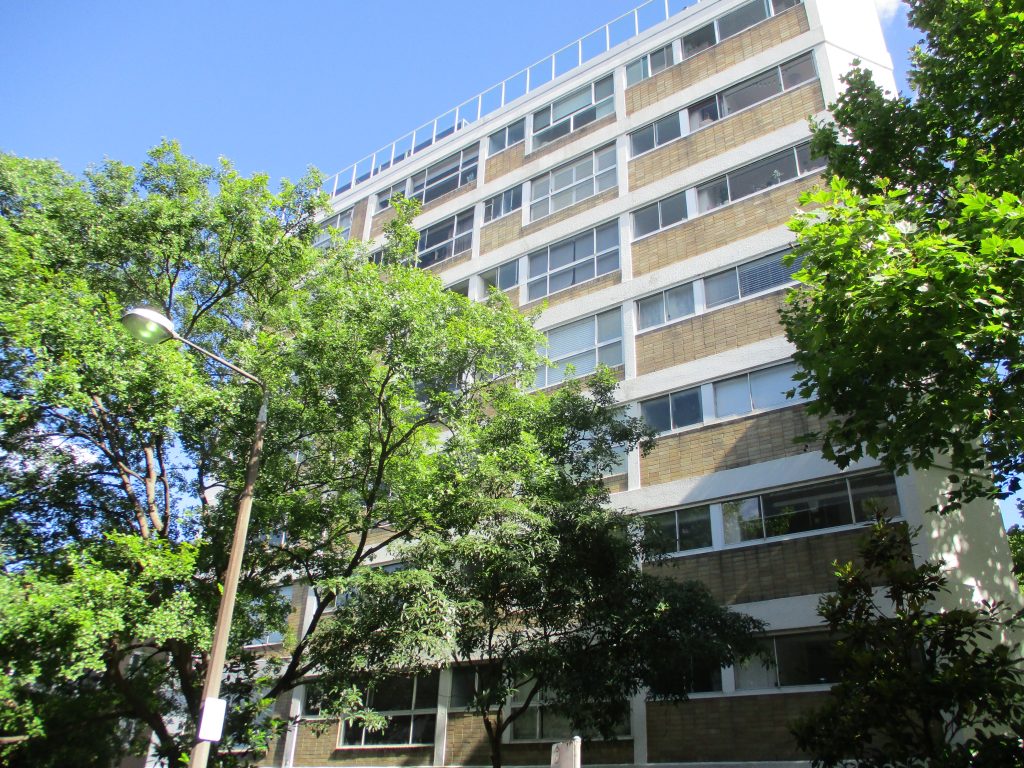HUGO STOSSEL, MID-CENTURY ARCHITECT

Potts Point and the eastern suburbs have been a magnet for European architects fleeing political persecution.
Hugo Stossel (1905-2002) was born in Hungary and trained as an architect in Vienna, Austria. He arrived in Sydney in 1938, aged 33, one of a number of émigré architects to arrive in Australia during the 1930s just before World War II officially broke out.
He designed Denison at 15 Wylde Street in 1966.
Apartment 26 is for sale through Angelo Bouras
https://www.rwebay.com.au/7819356/
In Europe he had worked on projects such as “Buffet Automat” (fast food cafes) in Bucharest, capital of Romania. An early photo shows him as a tall, slim elegant man in a fine tailored suit outside a European fast food cafe.
By 1939 he was registered as an architect in NSW and by 1945 at the end of the war he was a naturalised Australian citizen.
During the war he has worked in NSW as a project manager for Cody & Willis, a construction firm engaged mostly on government projects. He also took on some private work, including the design of Australia’s first prefabricated steel house in Ryde in 1946. He was innovative.
In the early post-war years he designed several small modernist houses for fellow émigrés. The first was in 1948 at Warrawee on Sydney’s upper north shore for Moses Eisner and his wife, Gisela. He also built house in 1948 in Wahroonga for company director Rudolf Nossal and his family, also from Vienna. In 1950 Stossel designed a house for his own family in East Lindfield, and another nearby for Viennese-born furniture designer Paul Kafka and his wife, Ilse. A fifth north shore house was built in 1952–53 on Collaroy Plateau for Swiss-born Walter Schwarz and his wife, Alison. The houses were featured in Sydney newspapers and published in well-read magazines such as “The Australian Women’s Weekly” and “Australian House & Garden”.
All of Stossel’s houses, including two built in Sydney’s eastern suburbs in the 1950s, are boldly geometric and feature open living spaces adjoining outdoor terraces. He utilised knee-high windows to maximise space and light, a design feature of Denison.
Denison also cleverly designs-in a whole home despite its small overall space. It doesn’t feel cramped despite being compact.
Stossel’s projects appeared in the 1954 publication “Sixty Beach and Holiday Homes” alongside architects such as Harry Seidler, Sydney Ancher and Arthur Baldwinson. His St. Ursula apartment block in Onslow Avenue, Elizabeth Bay, NSW, was described as his most ‘elegant’ project, completed in 1951. It was made with reinforced concrete and a steel curtain wall with floor to ceiling steel-framed windows to celebrate harbour views.
His work ethic was prodigious and included homes, high-rise apartments, factories, resorts, hotels, government office blocks, the NSW Police HQ (now demolished) and schools.
“Denison” at 15 Wylde Street is not an ostentatious building but retains Stossel design signatures such as large glass walls, also typical of other mid-century designs..
The Chimes apartments at 40 Macleay Street nearby is another Stossel design as is 41-49 Roslyn Gardens, a dramatic landmark in its streetscape.
He was hard working and submitted designs in 1954 for a proposed new Opera House & Concert Hall competition, the 1963 Rocks Redevelopment Scheme; proposed shops & flats at Hastings Street, Noosa Heads 1959, a block of flats, Sutherland Crescent, Darling Point c1962; Redevelopment of Queen Victoria Building site1974-1984, the 1963 21-storey Martin Place office block and the Nusa Dua resort, Bali 1976
Click on this link to see some of his interesting modernist designs: https://first.mhnsw.au/images_linked/recno56295B.pdf
Today, his contribution is only being recognised as a worthy contribution to our post-war, mid-century architectural deigns.
By Andrew Woodhouse
Heritage Solutions





